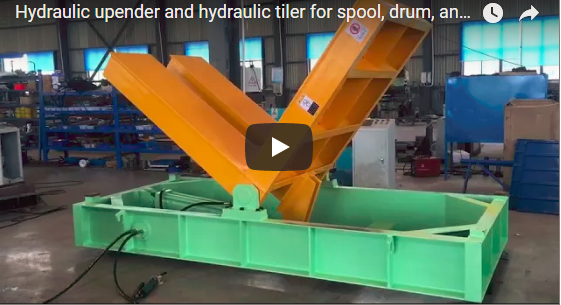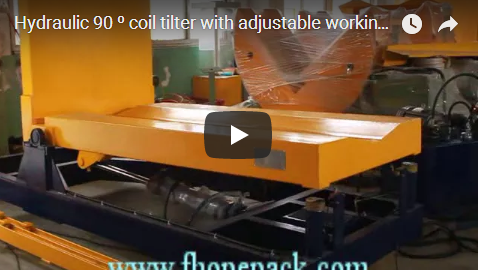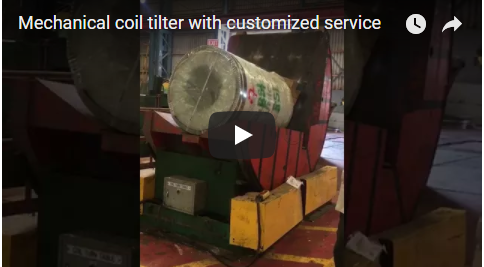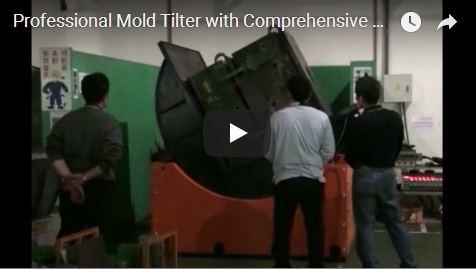Enhancing Material Handling Safety and Efficiency: An In-depth Look at Coil Upenders with Turntables & Rotary Tilters
Handling large, heavy, and often cylindrical objects like steel coils, molds, drums, or spools presents significant challenges in industrial environments. Manual handling is often impractical and unsafe, while traditional methods like cranes can be slow and risk damaging the product. Coil upenders, particularly those integrated with turntables and rotary tilters, offer a specialized mechanical solution to efficiently and safely reorient these heavy loads. This article provides a technical overview of these machines, their operational principles, key specifications, benefits, and common applications.
Video demonstrating the operation of a coil upender with an integrated turntable.
1. Operational Principles: Tilting and Rotating Heavy Loads
Coil upenders, also known as tilters or manipulators, are designed to securely grip and rotate heavy objects, typically by 90 degrees, between vertical and horizontal orientations. The core function involves a powered tilting mechanism acting on a load-bearing platform or structure.
- Tilting Action: Most commonly achieved via hydraulic cylinders or electro-mechanical drives (like screw jacks or gear motors), providing controlled and smooth rotation. The standard tilt is 90°, essential for changing the axis of a coil (e.g., from "eye-to-sky" to "eye-to-horizon"). Some designs offer 180° rotation for inversion tasks.
- Integrated Turntable: The addition of a powered turntable on the tilting platform allows the load to be rotated horizontally (typically up to 360°) after or before tilting. This crucial feature enables repositioning of the load for subsequent process steps (e.g., aligning a coil for unwinding, rotating a mold for access) without needing secondary handling equipment like forklifts or cranes, drastically improving workflow efficiency.
- Rotary Tilters: This term often emphasizes the combined tilting and rotating capabilities, highlighting the multi-axis manipulation possible with integrated turntable designs.
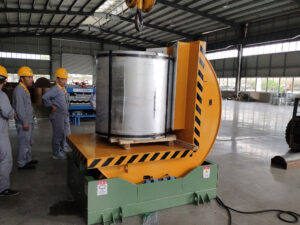
upender23 2. Key Technical Specifications and Design Considerations
Selecting the appropriate coil upender requires careful consideration of several technical parameters based on the specific application:
- Load Capacity: Ranges from a few hundred kilograms to over 50 tons. Must safely exceed the maximum weight of the objects being handled.
- Platform Size and Configuration:
- Dimensions must accommodate the largest load footprint.
- Surface options include flat plates, V-saddles (for coils), conveyor rollers, or custom fixtures tailored to specific object shapes (e.g., molds, drums).
- Tilting Angle: Typically 90° standard; 180° or custom angles available.
- Tilting Speed: Cycle time is influenced by the speed of the tilt mechanism. Variable speed control might be necessary for delicate loads. Usually ranges from 30 to 90 seconds for a 90° tilt, depending on size and drive type.
- Turntable Rotation: Speed and indexing capability (stopping at precise angular positions) are important for automated lines or specific positioning requirements.
- Drive System:
- Hydraulic: Offers high power density (suitable for very heavy loads) and smooth control. Requires hydraulic power unit (HPU) and potential for leaks.
- Electro-Mechanical: Cleaner operation, often preferred where hydraulics are undesirable. May use gear motors, chain drives, or screw mechanisms. Can offer precise positioning with VFDs or servo motors.
- Control System: Options range from simple pendant/push-button controls to integration with PLC systems for automated sequences. Features often include E-stops, cycle start/stop, manual/auto modes, and turntable rotation controls.
- Safety Features: Essential elements include:
- Emergency stop buttons.
- Limit switches to prevent over-travel.
- Velocity fuses on hydraulic systems to prevent sudden drops.
- Structural integrity calculations (FEA often used in design).
- Optional safety guarding/light curtains for automated cells.
- Power Requirements: Voltage (e.g., 380V, 480V), phase (3-phase common), and power consumption (kW or HP) depend on the drive system and capacity.
3. Core Benefits in Industrial Material Handling
Deploying coil upenders with turntables delivers tangible improvements:
- Enhanced Safety: Drastically reduces risks associated with manual handling or less stable lifting methods (e.g., using cranes with C-hooks or slings for tilting). Provides a stable, controlled rotation.
- Increased Efficiency: Significantly faster than manual or crane-based tilting/rotating methods. Integrating the turntable eliminates separate repositioning steps, reducing overall cycle time and equipment usage.
- Product Protection: Smooth, controlled motion prevents damage to sensitive products like steel coils (avoiding edge damage or telescoping), paper rolls, or intricate molds. The secure platform minimizes shock loads.
- Improved Ergonomics: Eliminates strenuous manual labor involved in maneuvering heavy or awkwardly shaped items, reducing worker fatigue and potential injuries.
- Operational Versatility: Can be designed to handle various load types beyond coils, including molds, dies, engines, chassis, paper rolls, and palletized goods, often with adaptable platform designs.
4. Common Applications Across Key Industries
The utility of these machines spans multiple sectors:
- Steel Processing & Distribution: Tilting steel coils (master coils, slit coils) between storage/shipping orientation (eye-to-sky) and processing orientation (eye-to-horizon) for decoilers or slitting lines. The turntable allows precise alignment.
- Automotive Manufacturing: Handling large stamping dies and injection molds, rotating them for maintenance, transport, or setup in presses.
- Paper and Pulp Industry: Safely tilting heavy paper rolls from vertical storage to horizontal processing orientation.
- Tool and Die Shops: Manipulating heavy tooling and molds for maintenance, repair, or inspection.
- Heavy Equipment Manufacturing: Tilting engines, transmissions, or other large components during assembly or testing.
- General Manufacturing: Handling drums of materials, large spools of wire/cable, or other bulky items requiring reorientation.
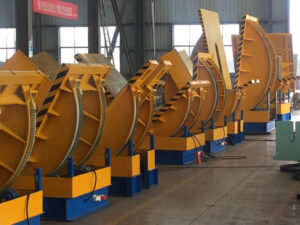
upender 5. Operational Best Practices and Maintenance Insights
To ensure longevity, safety, and optimal performance:
- Proper Loading: Ensure loads are placed centrally and securely on the platform/fixture as per manufacturer guidelines. Adhere strictly to weight capacity limits.
- Operator Training: Personnel must be trained on safe operating procedures, control functions, emergency stops, and load limitations.
- Regular Inspections: Implement a maintenance schedule including checks of:
- Structural components for stress or wear.
- Hydraulic systems for leaks, fluid levels, and hose condition.
- Mechanical drive components (chains, gears, bearings) for lubrication and wear.
- Electrical systems, sensors, and limit switches.
- Safety features functionality.
- Lubrication: Follow manufacturer recommendations for lubricating moving parts (bearings, pivot points, drive chains/screws).
- Environment: Keep the operating area clean and free of obstructions.
Conclusion
Coil upenders equipped with turntables and rotary tilters represent a significant advancement in handling heavy, bulky, or cylindrical loads. By providing controlled tilting and rotation within a single machine cycle, they offer substantial improvements in operational safety, workflow efficiency, and product protection compared to traditional methods. Understanding the core mechanics, key specifications, and application benefits allows engineers and operations managers to effectively integrate this technology into demanding industrial environments, optimizing material handling processes across various sectors.
https://www.fhopepack.com/Coil_upender.html
info@fhopepack.com

